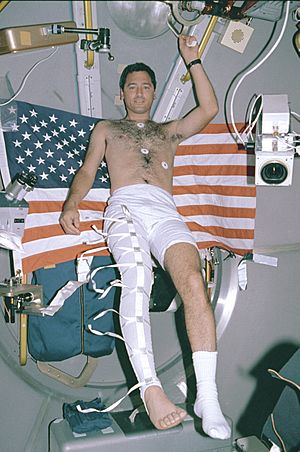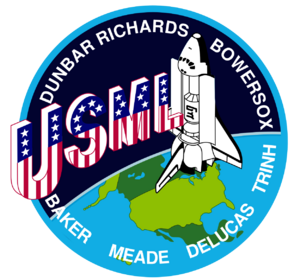STS-50 facts for kids

Spacelab Module LM1 in Columbia's payload bay, serving as the United States Microgravity Laboratory.
|
|
| Names | Space Transportation System-48 |
|---|---|
| Mission type | Microgravity research |
| Operator | NASA |
| Mission duration | 13 days, 19 hours, 30 minutes, 4 seconds (achieved) |
| Distance travelled | 9,200,000 km (5,700,000 mi) |
| Orbits completed | 221 |
| Spacecraft properties | |
| Spacecraft | Space Shuttle Columbia |
| Launch mass | 116,693 kg (257,264 lb) |
| Landing mass | 103,814 kg (228,871 lb) |
| Payload mass | 12,101 kg (26,678 lb) |
| Crew | |
| Crew size | 7 |
| Members |
|
| Start of mission | |
| Launch date | 25 June 1992, 16:12:23 UTC |
| Rocket | Space Shuttle Columbia |
| Launch site | Kennedy Space Center, LC-39A |
| Contractor | Rockwell International |
| End of mission | |
| Landing date | 9 July 1992, 11:42:27 UTC |
| Landing site | Kennedy Space Center, SLF Runway 33 |
| Orbital parameters | |
| Reference system | Geocentric orbit |
| Regime | Low Earth orbit |
| Perigee | 302 km (188 mi) |
| Apogee | 309 km (192 mi) |
| Inclination | 28.46° |
| Period | 90.60 minutes |
 STS-50 mission patch  Ellen S. Baker, Kenneth D. Bowersox, Bonnie J. Dunbar, Richard N. Richards, Carl J. Meade, Eugene H. Trinh, Lawrence J. DeLucas |
|
STS-50 was a NASA Space Shuttle mission, also known as the U.S. Microgravity Laboratory-1. It was the 12th flight of the Space Shuttle Columbia. This mission was special because Columbia landed at Kennedy Space Center for the first time. This happened because of bad weather at Edwards Air Force Base, caused by a storm.
Contents
Meet the STS-50 Crew
This mission had a crew of seven astronauts. They were all very important for the scientific work done in space.
| Position | Astronaut | |
|---|---|---|
| Commander | Richard N. Richards Third spaceflight |
|
| Pilot | Kenneth D. Bowersox First spaceflight |
|
| Mission Specialist 1 | Bonnie J. Dunbar Third spaceflight |
|
| Mission Specialist 2 | Ellen S. Baker Second spaceflight |
|
| Mission Specialist 3 | Carl J. Meade Second spaceflight |
|
| Payload Specialist 1 | Lawrence J. DeLucas Only spaceflight |
|
| Payload Specialist 2 | Eugene H. Trinh Only spaceflight |
|
What Was the STS-50 Mission About?
The STS-50 mission was all about studying how things behave in microgravity. Microgravity means a very weak pull of gravity, like what you feel when you are in orbit around Earth. This mission used a special lab called Spacelab inside the Columbia shuttle.
Key Goals of the Mission
The main goal was to do many science experiments in space. These experiments looked at different areas:
- Material science: How materials form and grow in space.
- Fluid physics: How liquids and gases move without strong gravity.
- Biotechnology: How living things and biological processes work in space.
This mission was also the first time a Space Shuttle flew with the Extended Duration Orbiter (EDO) equipment. This allowed the shuttle to stay in space much longer than usual.
Important Discoveries and Achievements
The STS-50 mission made several big achievements:
- It was the first dedicated flight of the United States Microgravity Laboratory-1 (USML-1). This helped prepare for future science on the Space Station Freedom.
- Astronauts completed 31 microgravity experiments. These covered fluid dynamics, crystal growth, how things burn, biological science, and testing new technologies.
- New experiment tools were used for the first time, like the Crystal Growth Furnace and the Drop Physics Module.
- Scientists on Earth could talk directly with the astronauts. This helped them change experiments to get the best results.
- It was the longest time protein crystals had ever grown on a Space Shuttle.
- The mission was the longest Space Shuttle flight at that time, lasting almost 14 days. It was also the first flight using the EDO system.
- The new Glovebox facility proved very useful. Astronauts could work with experiments safely, even with tricky materials.
Columbia launched into orbit for what was then the longest Shuttle flight ever. It landed almost 14 days later, bringing back lots of data and samples from its microgravity experiments.
Experiments in the Spacelab Module
Inside the Spacelab module, astronauts worked around the clock on more than 30 experiments. These studies focused on five main areas:
- Fluid dynamics: How liquids and gases react to forces in space.
- Materials science: How materials solidify and how crystals grow.
- Combustion science: How things burn in microgravity.
- Biotechnology: How living organisms and their products behave.
- Technology demonstrations: Testing new ideas for future space missions.
Three new major experiment tools flew on USML-1: the Crystal Growth Furnace, the Surface Tension Driven Convection Experiment, and the Drop Physics Module. Another new tool was the Glovebox. This allowed astronauts to handle small experiments safely, even if they involved liquids or gases.
Crystal Growth Furnace (CGF)
The Crystal Growth Furnace was used to study how crystals grow in microgravity. It could process up to six large samples at very high temperatures. Scientists wanted to see how crystals form without gravity's strong pull. This helps them understand how to make better crystals on Earth. For example, they grew gallium arsenide semiconductor crystals, which are used in fast electronics and solid-state lasers.
Surface Tension Driven Convection Experiment (STDCE)
This experiment studied how liquids move because of tiny differences in surface temperature. On Earth, gravity often hides these movements. In microgravity, scientists could clearly see these "thermocapillary" flows. This showed that surface tension is a powerful force for moving liquids in space.
Drop Physics Module (DPM)
The Drop Physics Module allowed scientists to study liquids without them touching a container. On Earth, liquids take the shape of their container. In space, sound waves were used to hold a liquid drop in the middle of a chamber. Astronauts could make drops spin, wiggle, combine, or even split. They even created the first "compound drop" (a drop inside another drop). This research could help in medical treatments, like putting medicines inside tiny membranes.
The Versatile Glovebox Facility
The Glovebox was a very useful new tool. It allowed astronauts to work with many different materials safely. It has a window, built-in gloves, and a special air system. This meant astronauts could handle even toxic or irritating materials without touching them directly. The Glovebox was mainly used to mix protein crystals and watch them grow. Astronauts could even change the mix during the mission to help the crystals grow better. They also did tests on candle flames, fiber pulling, and how particles spread.
Generic Bioprocessing Apparatus (GBA)
The Generic Bioprocessing Apparatus was used to process biological materials. It ran 132 different experiments. These studies looked at living cells, microorganisms, and the growth of brine shrimp and wasp eggs. One important study was on Liposomes, which are tiny spheres that could be used to deliver medicines to specific parts of the body, like a tumor.
Space Acceleration Measurement System (SAMS)
The SAMS instrument measured the tiny amounts of gravity (microgravity) that the experiments experienced. This data helps scientists understand if their experiment results were affected by any small movements or disturbances on the shuttle. SAMS has flown on many shuttle missions and is now on the International Space Station.
Mid-Deck Microgravity Experiments
While most experiments were in the Spacelab, some important ones were done in the Columbia's mid-deck. These included studies on Protein Crystal Growth, Astroculture, and Zeolite Crystal Growth.
Protein Crystal Growth
This experiment studied how protein crystals grow. Astronauts used the Glovebox to help these crystals grow better. They grew about 300 samples from 34 types of proteins. These included proteins important for understanding diseases like AIDS and human immune systems. The longer mission time helped the crystals grow larger and better. Scientists use these crystals to study the 3D shape of proteins, which can help in designing new medicines.
Astroculture Experiment
The Astroculture experiment tested a water system for growing plants in microgravity. Growing plants in space could provide food, oxygen, and clean water for astronauts on long missions. Since liquids act differently in space, normal watering systems don't work well. This experiment helped design better systems for space plants.
Zeolite Crystal Growth
The Zeolite Crystal Growth experiment processed 38 samples. Zeolite crystals are used to clean biological liquids, in laundry detergents, and for cleaning up waste.
Extended Duration Orbiter (EDO) System
STS-50 was the first flight to use the Extended Duration Orbiter (EDO) system. This system allowed the Space Shuttle Columbia to stay in orbit for almost 14 days. Future missions with EDO could last even longer, up to a month. The EDO kit added extra tanks for power, extra nitrogen for the cabin air, and a better system to remove carbon dioxide. This was important for preparing for long-term research on the Space Station Freedom.
Astronauts also did health tests as part of the EDO Medical Project. They checked their blood pressure and heart rate. They also tested a device called the Lower Body Negative Pressure (LBNP) device. This device helps astronauts deal with the fluid changes that happen in space. If it worked well, it could help them feel better when they return to Earth.
Other Activities on STS-50
Shuttle Amateur Radio Experiment (SAREX)
The STS-50 crew also used the Shuttle Amateur Radio Experiment (SAREX). They talked to amateur radio operators on Earth, including a sailing ship in the Pacific Ocean and schools around the world. It was a fun way to connect with people on Earth.
Polymer Membrane Processing (IPMP)
The Investigations into Polymer Membrane Processing (IPMP) experiment studied how polymer membranes form in microgravity. These membranes are used as filters in medical and industrial processes. The goal was to make better filters by understanding how they form in space.
STS-50 Mission Patch
The mission patch shows the space shuttle flying in a way that's good for microgravity experiments. A banner with "USML" (U.S. Microgravity Laboratory) extends from the shuttle's cargo bay. The "μg" symbol for microgravity is also shown. The stars and stripes on the USML letters and the highlighted United States on Earth show that this was an all-American science mission.
Space Debris and Micrometeoroids
During the mission, the Columbia orbiter was hit by small pieces of space debris and tiny meteoroids. It had 40 impacts from radiation debris, impacts on eight windows, and three impacts on the wing edges.
Images for kids






